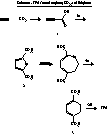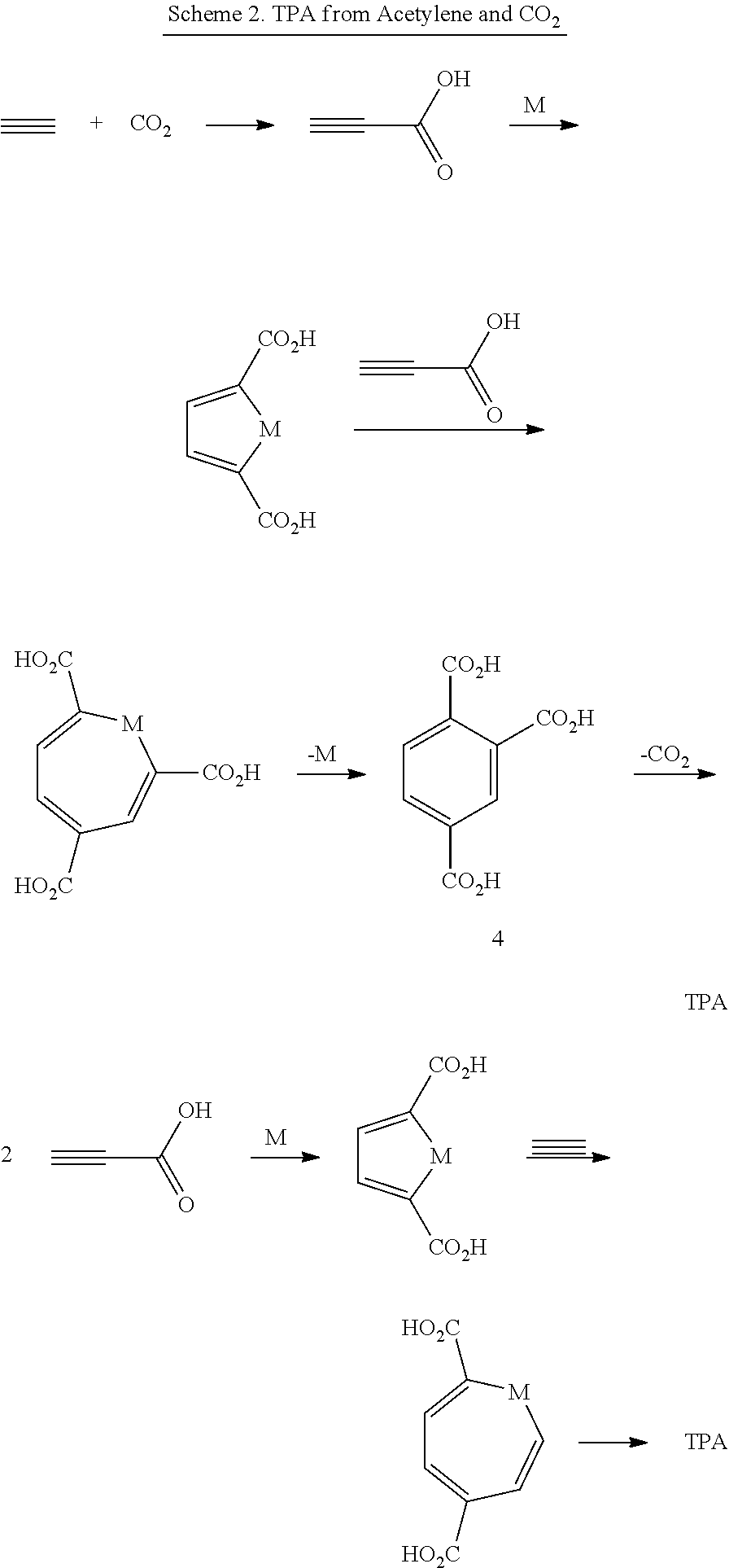Production Of Terephthalic Acid Via Reductive Coupling Of Propiolic Acid Or Propiolic Acid Derivatives
a technology of terephthalic acid and reductive coupling, which is applied in the preparation of carboxylic compounds, organic chemistry, chemistry apparatus and processes, etc., can solve the problems of fossil resources such as crude oil, natural gas, coal, peat, etc., and has not yet demonstrated commercial viability of the process
- Summary
- Abstract
- Description
- Claims
- Application Information
AI Technical Summary
Benefits of technology
Problems solved by technology
Method used
Image
Examples
example 1
Synthesis of Ethyl Propiolate
[0035]Propiolic acid (310 μL, 5 mmol; Alfa Aesar, Ward Hill, Mass.; catalog # A13245) was dissolved in 13 mL of ethanol, giving a colorless solution, to which concentrated sulfuric acid (139 μL, 2.5 mmol) was added. The resulting mixture was heated to reflux for 24 h, and then treated with 13 mL of water before being extracted with dichloromethane (10 mL; three times). The combined organic layers were washed with water (10 mL; three times) and brine (10 mL), and then dried over anhydrous Na2SO4 (Thermo Fisher Scientific, Pittsburgh, PA; catalog # S421-3). Removal of the solvent under vacuum afforded the product as a light yellow color oil (177 mg, 36% yield). 1H NMR (400 MHz, CDCl3, δ): 4.26 (q, 3JH-H=7.1 Hz, CH2, 2H), 2.92 (s, C≡CH, 1H), 1.33 (t, 3JH-H=7.2 Hz, CH3, 3H).
example 2
Catalytic [2+2+2] Cyclotrimerization of Ethyl Propiolate
[0036]Under an argon atmosphere, Ni(COD)2 (5.5 mg, 0.020 mmol; Acros, Pittsburgh, Pa.; catalog # 223970050) and PPh3 (15.6 mg, 0.060 mmol; Sigma-Aldrich Co., St. Louis, Mo.; catalog # T84409) were mixed in 10 mL of toluene at 23° C. The resulting mixture was stirred at this temperature for 5 min to produce a stock solution of the catalyst. A portion of the stock solution (375 μL) was added to a 10 mL scintillation vial under an argon atmosphere and the volume was brought to 2 mL with toluene, followed by the addition of ethyl propiolate (152 μL, 1.5 mmol). The reaction was complete within 2 h, producing a mixture of 1,2,4- and 1,3,5-isomers in a 97:3 molar ratio. The 1,2,4-isomer (triethyl trimellitate) was separated from the isomeric mixture using column chromatography (eluted with diethyl ether / hexanes) and isolated in 92% yield. 1H NMR (400 MHz, CDCl3, δ): 8.41 (1H, d, 4JH-H=1.7 Hz, ArH), 8.20 (1H, dd, 3JH-H=7.9 Hz, 4JH-H=1....
example 3
Hydrolysis of the 1,2,4- and 1,3,5-isomers of Benzenetricarboxylic Acid Triethyl Ester to Trimellitic Acid and Trimesic Acid
[0037]The 97:3 mixture of 1,2,4- and 1,3,5-isomers of benzenetricarboxylic acid triethyl ester (294 mg, 1.0 mmol) was dissolved in 40 mL of water-ethanol (1:1) mixture. NaOH (240 mg, 6.0 mmol) was added, and the resulting mixture was stirred at 23° C. for 12 h. Upon completion of the reaction, the solution was acidified using a concentrated HCl solution (the acidity of the solution was monitored using pH paper). The resulting solution was concentrated under vacuum, and the residue was extracted with diethyl ether (15 mL; three times). The combined organic layers were dried over anhydrous Na2SO4 and then pumped to dryness. A mixture of 1,2,4- and 1,3,5-isomers of benzenetricarboxylic acid (94:6 molar ratio) was isolated in 77% combined yield (161 mg, light yellow solid). 1H NMR (400 MHz, DMSO-d6, δ): 1,2,4-isomer: 13.44 (br, COOH, 3H), 8.21 (d, 4JH-H=1.2 Hz, ArH...
PUM
 Login to View More
Login to View More Abstract
Description
Claims
Application Information
 Login to View More
Login to View More - R&D
- Intellectual Property
- Life Sciences
- Materials
- Tech Scout
- Unparalleled Data Quality
- Higher Quality Content
- 60% Fewer Hallucinations
Browse by: Latest US Patents, China's latest patents, Technical Efficacy Thesaurus, Application Domain, Technology Topic, Popular Technical Reports.
© 2025 PatSnap. All rights reserved.Legal|Privacy policy|Modern Slavery Act Transparency Statement|Sitemap|About US| Contact US: help@patsnap.com


